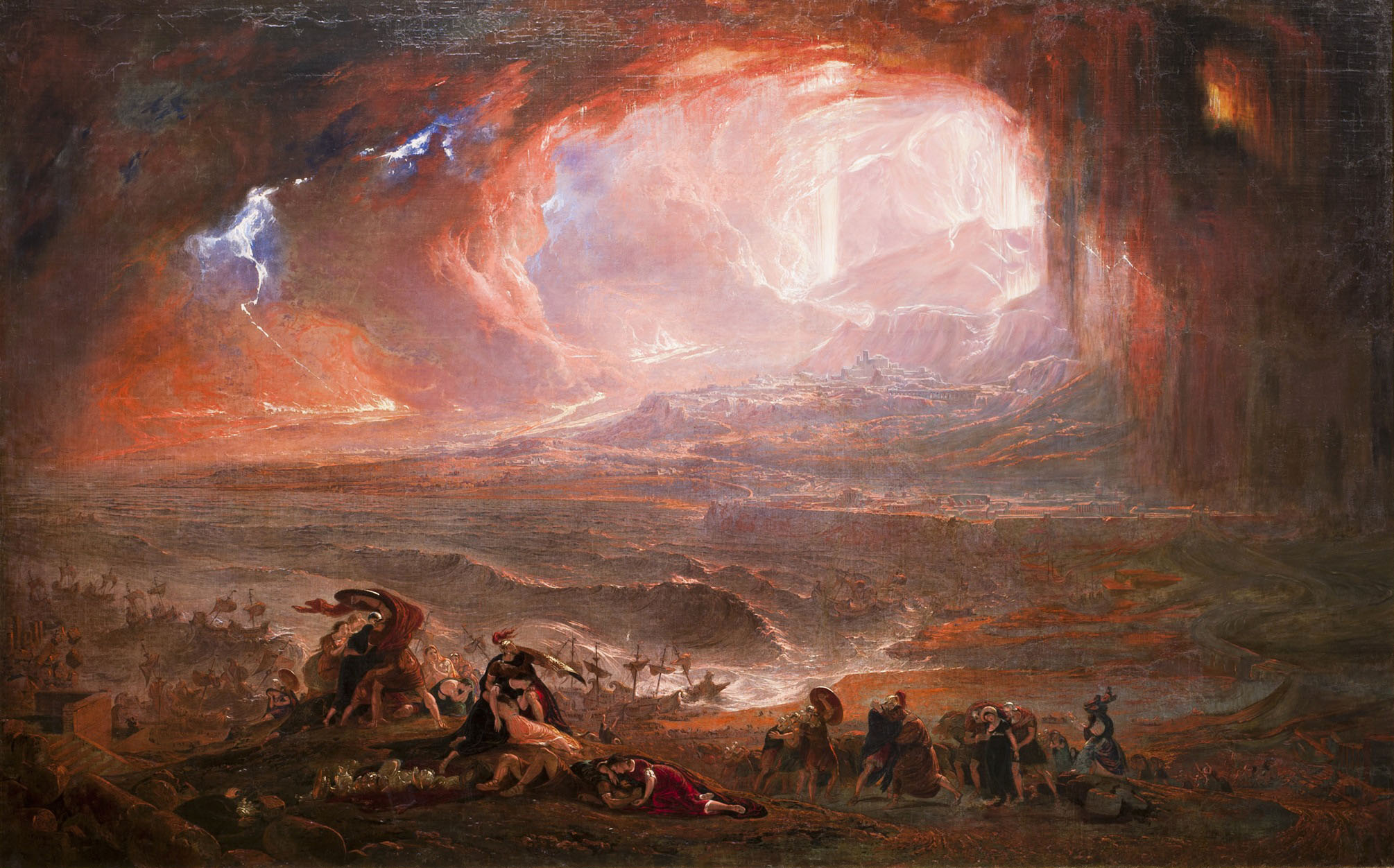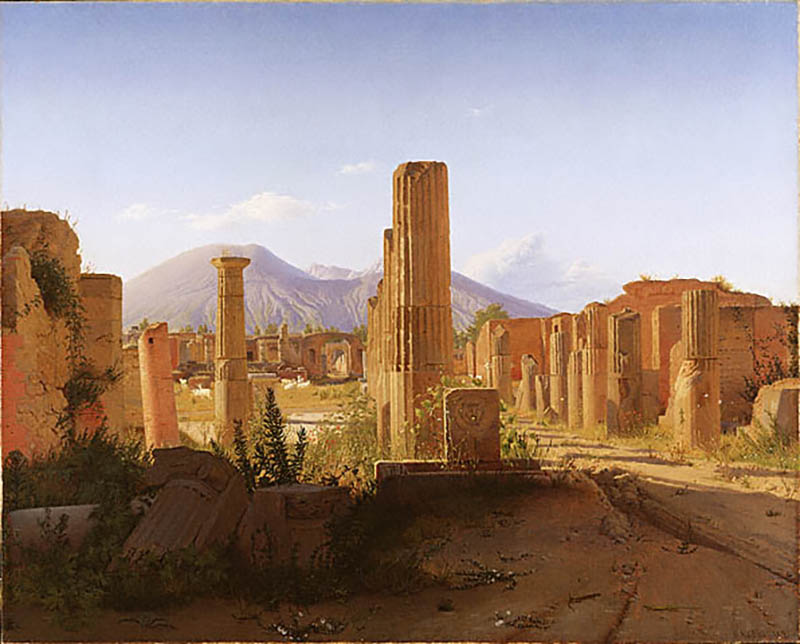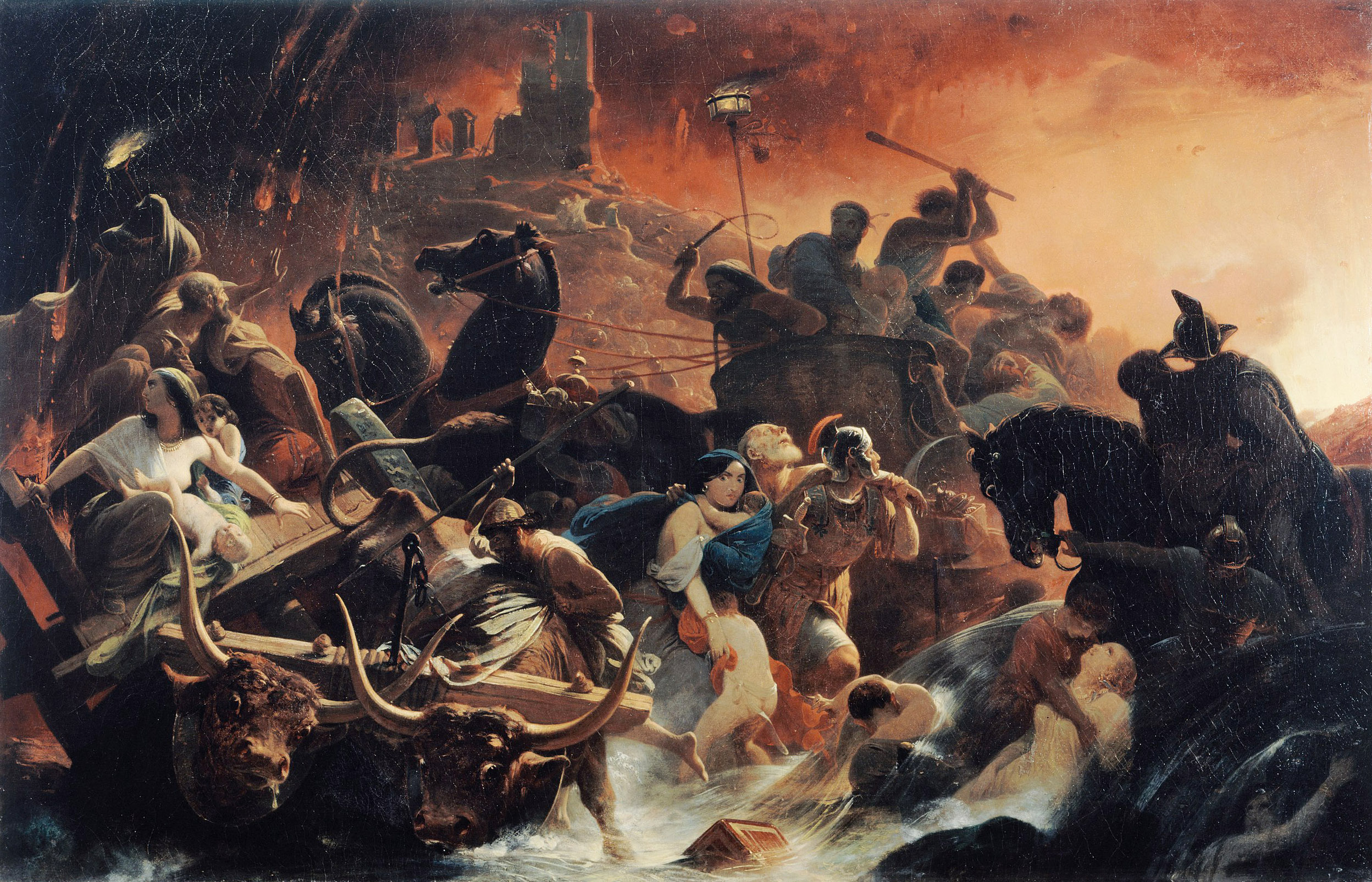The Last Days of Pompeii: Decadence, Apocalypse, Resurrection
By Victoria C. Gardner Coates, Kenneth Lapatin and Jon L. Seydl | Getty Trust Publications | $69.95
The cataclysmic eruption of Vesuvius on 24 August AD 79 wiped out Pompeii, Herculaneum and other towns on the Bay of Naples. Yet the event would scarcely have rated a mention in the annals of Roman history had it not been witnessed by a member of the Roman elite, Gaius Plinius Caecilius Secundus (Pliny the Younger), whose uncle, the commander of the Roman fleet, sailed across from the naval base at Misenum to inspect the eruption (and died as a result). Pliny the Younger was a prolific letter-writer, and his first-hand account of the eruption has come down to us in two letters he wrote years later at the request of the historian Tacitus.
There the matter would have rested except for the chance find of Roman antiquities in a well at Resina (now known as Ercolano) near Naples at the beginning of the eighteenth century. What began as an accident led to the rediscovery of Herculaneum and then of Pompeii. The excavations of these two Roman towns caused sensation after sensation and still have the capacity to create headline news.
Although The Last Days of Pompeii takes its title from Edward Bulwer-Lytton’s immortal 1834 novel, it is not concerned with the finds at Pompeii or the archaeological history of the region. Instead, under the three broad themes of decadence, apocalypse and resurrection, it explores the perennial public fascination with Pompeii and the way artists have used the town as a metaphor for ideas that have little to do with antiquity.
The publication of the book coincides with an exhibition that began at the J. Paul Getty Museum in Malibu, has just left the Cleveland Museum of Art and is due to open shortly at the Musée National des Beaux-Arts du Québec. The exhibition, which looks at Pompeii not as a window to the past but as a mirror of the present, consists of paintings and objects drawn from major art collections around the world. These are finely illustrated in the catalogue section of the book and are prefaced by essays written by a number of distinguished scholars.
Attempts to portray Pompeii as another Sodom and Gomorrah, a decadent city of excess that somehow deserved the disastrous eruption, have taken different forms at different times. An 1827 painting by Joseph Franque, of a mother and her two daughters being enveloped by the fire of the eruption, shows voluptuous, semi-naked creatures decked in jewellery and lacking classical decorum. Their selfishness and greed in lingering to gather up their jewellery has spelt their doom. Francesco Netti’s Gladiator Fight during a Meal at Pompeii (1880) is a frankly shocking scene of an orgiastic banquet taking place while attendants drag off the body of a gladiator who has been killed for the delectation of the diners. In a 1984 interview for Playboy the British actor and writer Joan Collins used the analogy of Pompeii to underline her belief that herpes and AIDS were plagues sent to “teach us all a lesson.”
The ancient setting gave nineteenth-century painters like Théodore Chassériau and Lawrence Alma-Tadema licence to show naked females flaunting their bodies in archaeologically correct Pompeian spaces, and allowed Wilhelm von Gloeden and Guglielmo Plüschow to indulge their taste for young male nudes photographed against an antique backdrop. Sometimes a painting adopts a more moralising tone, like An Exedra by Lawrence Alma-Tadema, which shows the sorry state of an exhausted slave while his masters idly take their ease. Sometimes titillation is the subject, such as in Luigi Bazzani’s A Visit to Pompeii, in which two well-dressed young women of the late nineteenth century are shown eyeing a fresco of a naked man.
This ambivalence towards the perceived sexual licence of Pompeii is exemplified by the Secret Cabinet of the Naples Archaeological Museum, a repository for objects from Pompeii that were considered obscene. Access to this chamber, now open to the public, was once strictly limited to men who had undergone the complex procedures required for admission. Women, young people and persons in holy orders were not admitted at all. Murray’s Handbook to South Italy and Naples (1853) sanctimoniously states that because permission was exceedingly difficult to obtain “very few therefore have seen the collection; and those who have, are said to have no desire to repeat their visit.”
The rediscovery of Pompeii coincided with a number of natural disasters, such as the Lisbon earthquake of 1755, and the eruption of Vesuvius came to be seen as illustrative of the insignificance of human beings when confronted with disasters of such magnitude. Painters such as Jacob More depicted the erupting mountain as a sea of red threatening to overwhelm a handful of small, pitiful fleeing figures. Other saw it as God’s judgement on a heathen people, another Sodom and Gomorrah.

The Destruction of Pompeii and Herculaneum, by John Martin, c. 1822–26. Oil on canvas, 83.8 x 121.9 cm. Tabley House Collection, University of Manchester/The Bridgeman Art Library
John Martin’s 1822 painting The Destruction of Pompeii and Herculaneum (above) is one of a series of apocalyptic visions influenced by dioramas of historical disasters. Extremely popular at the time, these dioramas, or “pyrodramas,” were accompanied by dancing and gladiatorial battles and culminated in the fiery destruction of a set depicting Pompeii. Henri-Frédéric Schopin’s The Last Days of Pompeii (1850) (main picture) shows a chaotic scene in which men, women, children, chariots, horses and even a bullock team trample each other in an effort to escape the inferno. The most famous painting of this genre, Karl Bryullov’s enormous painting of 1833, The Last Day of Pompeii, shows an apocalyptic scene with terrified figures fleeing a fiery holocaust that lights up their faces and reveals expressions of fear, greed, hope and heroism. Significantly, an elderly man in the foreground wears a Christian cross as he faces the sea of fire.
James Hamilton’s painting of 1864 on the same theme shows a great column about to topple, a reference to the statue of Augustus, which fell and killed the villainous Arbaces at the end of Bulwer-Lytton’s novel. One of the most moving apocalypse paintings is Edward John Poynter’s Faithful unto Death (1865), which shows a solitary Roman legionary lit up by the red glow of the flames, standing ready to meet his end. The young man, under orders not to leave his post but tense with fear as the fireballs rain down behind him, is the embodiment of the ideals of Victorian England.
Perhaps the most curious painting reproduced in this book is Auguste Desperret’s Third Eruption of the Volcano of 1789, painted in 1833. It shows the word “liberté” exploding from the mouth of Vesuvius, which erupted in 1789, thus marking the French Revolution during which Louis XVI was beheaded. Another eruption in 1830 marked the overthrow of Charles X, a younger brother of Louis XVI. Desperret is here looking forward to a third eruption, which would mark the overthrow of King Louis Philippe, who had inspired such great hatred among the lower classes of France and was to be the last king of France.
Some painters chose to depict not the eruption but its aftermath. In 1799 Jakob Philipp Hackert painted Pompeii as a ruin through which humans and animals were wandering, and a painting by Christen Kobke (below), The Forum, Pompeii, with Vesuvius in the Distance (1841), shows only a ruin, devoid of human beings, a city destroyed and deserted. The sky is clear blue, Vesuvius is tranquil and no longer a threat, and the ruins are gradually becoming overgrown.

The Forum, Pompeii, with Vesuvius in the Distance, by Christen Købke, 1841. Oil on canvas, 70.8 x 87.9 cm. Los Angeles, J. Paul Getty Museum, 85.PA.43
During the second world war Pompeii suffered extensive bombing, but it was not so much the damage that evoked artistic responses; instead, the horrors of the war modified the way artists viewed the town. As a reaction to the depiction of formal beauty, a sculpture like César’s Seated Nude, Pompeii (1954) showed a dematerialised skeletal form composed of metal castings. In the Seagram murals (1958–59) Mark Rothko used Pompeian red to create an atmosphere in which his wealthy clients would seem to be stifled and buried like the people of Pompeii. Andy Warhol likened the eruption of Vesuvius to the explosion of an atomic bomb, and his depictions – with their frenzied, somewhat erotic quality and Vesuvius’s flesh-coloured cone – were designed to give the impression that they were painted only minutes after the eruption.
WHAT makes Pompeii and Herculaneum unusual archaeological sites is how complete are their buildings, furnishings, wall-paintings and even the food that their inhabitants were about to eat that fateful morning. Despite this abundance of material, though, little is known about the identity of their inhabitants, except for a few names and a few graffiti scratched on walls. This has resulted in an unparalleled attempt to repopulate the city with imaginary characters. The most celebrated attempt was by Edward Bulwer-Lytton, whose fictional characters became a point of reference for many of the houses in Pompeii – especially the House of the Tragic Poet, which was the residence of the novel’s hero, Glaucus.
Unfortunately, attempts to infuse life back into Pompeii by, for example, staging gladiatorial battles in the amphitheatre, failed, extravaganzas of this type proving more successful when enacted elsewhere. The recreation of the bodies of dead Pompeians from plaster casts also failed to resurrect the town’s inhabitants, but it did spawn a new industry. These white ghostly figures were taken out and set up in dramatic poses, often facing up instead of down, the way they were discovered. They were then photographed in bright light, sometimes against a dramatic backdrop such as Vesuvius, the mountain that killed them. Allan McCollum found these casts – and especially the cast of a chained-up dog writhing in its death throes – unsettling. His work, The Dog from Pompei (1991) consists of multiple casts of the same original to show that no amount of copying can bring the dog back to life.
Another comment on our tendency to use artefacts to engage with history is Michael Huey’s Pompeii (2008). On the face of it, this is simply a large-scale coloured reproduction of a Fourth Style wall-painting from Pompeii. But it is produced by an analog process and based on a modern photograph of a photograph taken in 1870 that shows the reconstruction of the painting based on surviving fragments. Huey’s work is thus so far removed from the original of AD 64 that the ability of photography to convey meaning comes under question.
Photographic images did become an important part of the rediscovery process, however, because archaeology is by its very nature destructive, and photography could provide images of the site before, during and after excavation. In an interesting juxtaposition, the book shows a painting by Edouard Alexandre Sain called Excavations at Pompeii (1865), with graceful barefooted women carrying away the dirt from the excavation in baskets on their heads. On the next page is a photograph called Pompeii – Recent Excavations (1892–94), in which a number of sullen-looking Neapolitan boys, dressed in rags, carry away baskets of dirt under the watchful eye of an overseer armed with a long cane.
Pompeii has of course been recreated in cinema. One of the earliest of these movies, Luigi Maggi’s 1908 film, Gli ultimi giorni di Pompeii (The Last Days of Pompeii), is based on Bulwer-Lytton’s novel and covers the entire plot, against a series of sumptuous backdrops, in a matter of minutes. Even more sumptuous was Rodolfi’s 1913 version of the same story, which lasted more than a hundred minutes and involved hundreds of extras. Christianity does not feature in either of these films. Instead, the morally superior Romans are shown as being undermined by the Oriental duplicity of Arbaces. The theme of morally superior Romans, which appealed to the fascists, is reinforced in the increasingly longer and more lavish films of the 1920s and 30s. They also showed greater historical authenticity than their American counterparts, although by then Hollywood productions were becoming more successful at the box office. Since then, exhibitions about Pompeii have been more successful than films, and are by now so numerous that they require an appendix nine pages long in the book.
The late 20th century saw a new shift in the way the site can be viewed. Thanks to digital reconstructions we can now fly through Pompeii, peering into houses, listening to the splash of the fountains and seeing carts rumbling by. We can even relive the eruption of AD 79 in the sensational 3D video created in Melbourne for the Pompeii exhibition of 2009. Boulders fly past our heads and roofs collapse in front of our eyes as Vesuvius rumbles ever louder in the background. Computer simulations have also found their way into the sites themselves. There is a Museum of Virtual Archaeology at Herculaneum, and at Pompeii no less a guide than Julius Polybius himself, in the form of a hologram, conducting visitors around his house. But although these technologies have been successful in bringing Pompeii into the modern era, they have also been criticised as creating a Pompeii that suits our modern conceptions of what an ancient Roman city was like.
But this is what this book is all about. Pompeii is a mirror and each generation has superimposed its own values and ideas. It is more than an archaeological site – it has been a reflection of the fears, dreams, aspirations and fantasies of artists and writers, and their audiences, for over 250 years. •




